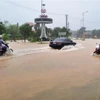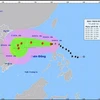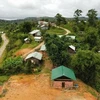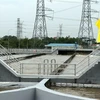An increase in sea levels over the last ten years is responsible for the disappearance of many beautiful beaches and parts of protected forests in the central province of Quang Nam, which boasts a 125km coastline.
Sea waters are even encroaching upon coastal residential areas in Nui Thanh district and Hoi An city.
The commune of Tam Hai island in Nui Thanh district has seen sea waters encroaching by 50m in the last five years. As a result, the local authorities have planned to relocate approximately 200 households from the most severely affected village, Thuan An.
Many villagers have migrated to the mainland as they fear the impacts of more frequently occurring natural disasters, said Nguyen Tan Hung, a commune official in charge of agriculture.
According to Hung, since the construction of 2km of protective dykes along the coast in Tam Hai commune in 2012, landslides have decreased and people’s lives have stabilised. However, a 30m section of the embankment was damaged in a storm in late 2013.
The commune needs to expand the dyke system by 2.4 km along the villages of Thuan An and Binh Trung, since sea levels have been rising encroaching upon these localities by nearly 10m each year, he added.
Rising sea levels and erosion are also affecting Cua Dai beach in Hoi An city where many high-end resorts are located. The sea is now only 40m away from roads, and tides have eroded the coast to the extent that in this area some beaches have been swept away completely.
This is particularly difficult for resorts as they now have to explore ways to protect their assets from further encroachment of the sea.
According to Ngo Van Hoang, Director of SunRise Resort, in the last eight years sea level rises and erosion have impacted on more than 200m of the property, forcing the resort to spend 1 million USD on the construction of embankments. However, the embankments could not withstand the ocean’s high waves.
The increase in sea levels has negatively impacted business for resorts as there are now fewer beaches left for tourists, he revealed.
Together, resorts have invited experts from the Netherlands to survey the area and propose solutions, but the construction of a complex dyke system goes beyond their means due to its very high costs, he added.
In 2010 the province approved a 299 billion VND (14.2 million USD) project to prevent the sea from further encroaching on Hoi An’s coast. To date, only 714m of dykes have been built.
According to the province’s climate change scenario for 2020, flooding will mainly occur in low-lying coastal areas, resulting in over 306 sq.km being submerged.
The city of Hoi An will be hit hardest, with flooding predicted in more than 26 percent of the city; followed by Dien Ban district with 26 percent; Duy Xuyen district with 16 percent; and Nui Thanh district with 15 percent.-VNA
Sea waters are even encroaching upon coastal residential areas in Nui Thanh district and Hoi An city.
The commune of Tam Hai island in Nui Thanh district has seen sea waters encroaching by 50m in the last five years. As a result, the local authorities have planned to relocate approximately 200 households from the most severely affected village, Thuan An.
Many villagers have migrated to the mainland as they fear the impacts of more frequently occurring natural disasters, said Nguyen Tan Hung, a commune official in charge of agriculture.
According to Hung, since the construction of 2km of protective dykes along the coast in Tam Hai commune in 2012, landslides have decreased and people’s lives have stabilised. However, a 30m section of the embankment was damaged in a storm in late 2013.
The commune needs to expand the dyke system by 2.4 km along the villages of Thuan An and Binh Trung, since sea levels have been rising encroaching upon these localities by nearly 10m each year, he added.
Rising sea levels and erosion are also affecting Cua Dai beach in Hoi An city where many high-end resorts are located. The sea is now only 40m away from roads, and tides have eroded the coast to the extent that in this area some beaches have been swept away completely.
This is particularly difficult for resorts as they now have to explore ways to protect their assets from further encroachment of the sea.
According to Ngo Van Hoang, Director of SunRise Resort, in the last eight years sea level rises and erosion have impacted on more than 200m of the property, forcing the resort to spend 1 million USD on the construction of embankments. However, the embankments could not withstand the ocean’s high waves.
The increase in sea levels has negatively impacted business for resorts as there are now fewer beaches left for tourists, he revealed.
Together, resorts have invited experts from the Netherlands to survey the area and propose solutions, but the construction of a complex dyke system goes beyond their means due to its very high costs, he added.
In 2010 the province approved a 299 billion VND (14.2 million USD) project to prevent the sea from further encroaching on Hoi An’s coast. To date, only 714m of dykes have been built.
According to the province’s climate change scenario for 2020, flooding will mainly occur in low-lying coastal areas, resulting in over 306 sq.km being submerged.
The city of Hoi An will be hit hardest, with flooding predicted in more than 26 percent of the city; followed by Dien Ban district with 26 percent; Duy Xuyen district with 16 percent; and Nui Thanh district with 15 percent.-VNA



















